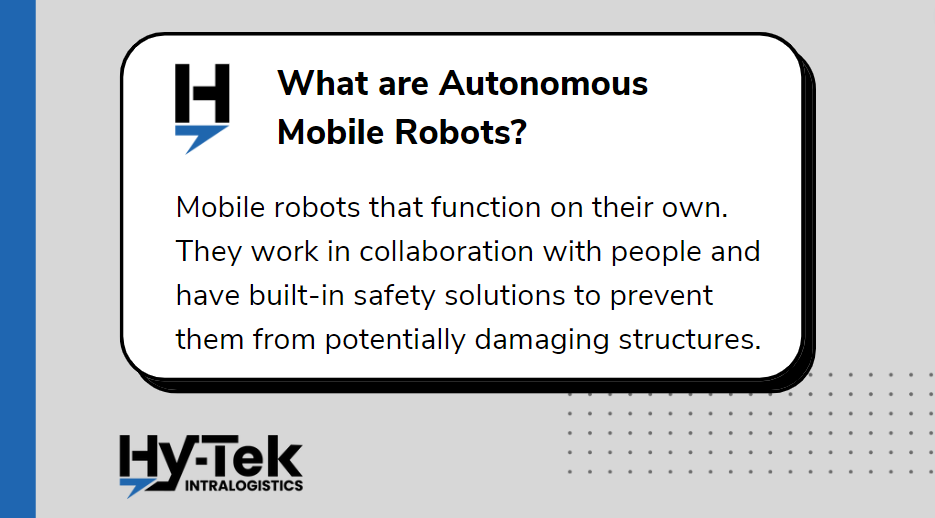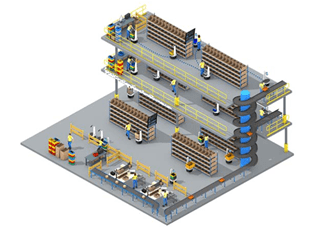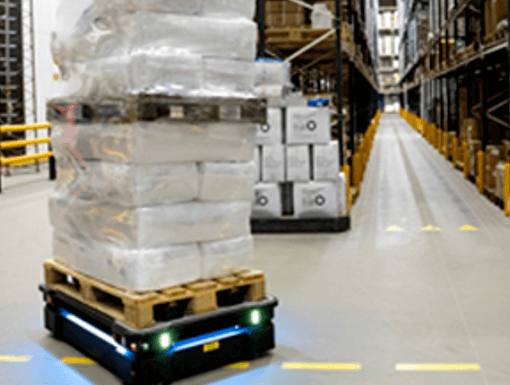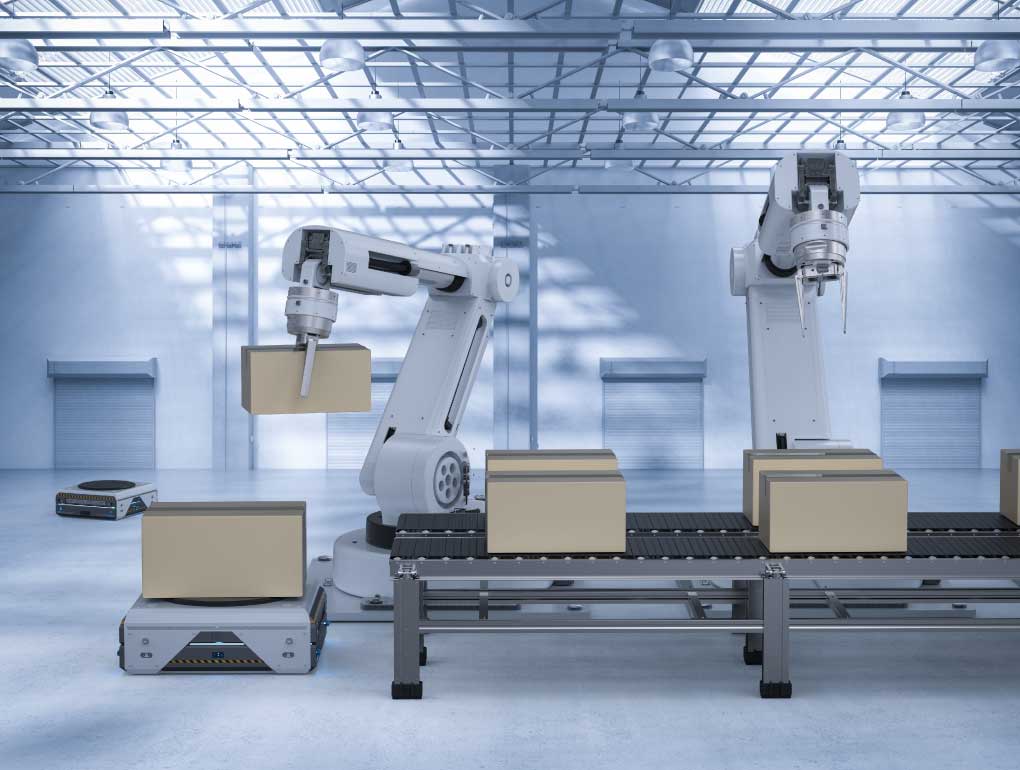As the Distribution and Logistics job market and labor costs continue to change, the advancements of technology are constantly improving the way Autonomous Mobile Robots (AMRs) are used.
And with these improvements, the industry outlook shows minor signs of slowing, and Business Wire projects a global CAGR (compound annual growth rate) of 15.12% from 2021 to 2026.
However, when it comes to AMRs, there are several different types. Each one can flourish in the right setting and flounder in the incorrect application, so identifying the correct type of industrial robots for you is critical.

What are Autonomous Mobile Robots?
Autonomous mobile robots are machines that function on their own. They work in collaboration and cohabitate with people, and they have safety solutions on board that prevent them from damaging structures.
These safety detections or device detection and destruction detection solutions are called LiDAR or “light detection and ranging,” which is a 360-degree looking solution that looks for fixed obstructions (racks, posts, workstations, etc.) or variable obstructions (people, forklifts, and pallets). LiDAR allows the autonomous robot to stop and work safely with people around them.
What makes AMRs unique compared to some of their predecessors (like automated guided vehicles (AGVs)) is their mapping capability. Not only will they map the entire facility, but they also regularly update that map with the most efficient routes possible.
For example, if an autonomous mobile robot goes down, it will identify where on the map it was obstructed, and, if integrated with a warehouse control system, it will then automatically reroute itself back to another path that’s available to it.
Another advantage is that they constantly monitor their battery life. If they realize that they’re running low, they can immediately take themselves out of service, pausing their current queued tasks, and automatically go onto a charger. Once charged, the autonomous robot will resume its tasks right where it left off.
In a nutshell, AMRs possess a higher level of intelligence than the previous level of technology; they can make decisions about rerouting. Without human control, they can decide how to do their work based on what is optimal.
Why are AMRs Relevant in 2022 and What Impact Have they Had Since Creation?
There are many reasons for AMRs popularity, but the main ones are rising labor costs due to a shrinking number of workers, more aggressive delivery times, and technological advancements.
With those advancements, Autonomous Mobile Robots have changed quite a bit from what everybody initially thought they would be.
We see in the industry that they have had less impact on the picking process (like many originally expected) and are used more as a transport device.
In 2022, using AMRs for picking processes and horizontal transportation is more commonly accepted due to their efficiency and proven ROI.
To add to these two types, mobile sortation robots have garnered quite a bit of interest.
They are moving robotic orders, where you may have many pickup points and many diverting destinations.
And if you put in a physical conveyor or a shoe-type sortation solution, it would have had too many inducts and too many diverts for a low-cost solution.
Types of Autonomous Robots
- Collaboration Robots
- Inventory Transportation Robots
- Scalable Storage Picking Robots
- Automatically Guided Vehicles (AGVs)
1. Collaboration Robots

The most common autonomous mobile robots are collaboration robots.
Some examples are Fetch Robotics, Otto Motors, and GreyOrange.
These programmable robots are built to work in put-away, picking, counting, replenishment, and sorting applications.
They work by receiving a download of orders and going to the pick location indicated where there is an operator stationed to receive the pick.
The operator then moves to that location and either picks the product out of storage and puts it into the robot or pulls the item from the robot and places it onto a shelf, conveyor, or rack. The worker then taps a “complete” button, telling the robot to go off and transport inventory to the following location.
The AMR in this situation handles horizontal transportation with products or goods across a facility while the more complex processes, like picking, sorting, or unpacking, are handled by a worker.
Walking distances drive the need for Full-Time Equivalent (FTEs) or people and equipment. The more walking required, the more FTEs needed in your supply chain operation.
This benefits a company and warehouse managers by reducing walking distances for workers, removing the labor time that workers spend traveling in a facility, enhancing worker safety, and keeping workers engaged in the more complex and involved tasks, thereby reducing the overall FTEs needed.
However, there are some disadvantages to collaboration robots.
Firstly, this solution does not completely cut out the walk for the workers because they still must find the robots and go to those solutions to pull the necessary items from the robot.
Thus, it’s still a person to goods solution instead of a goods-to-person solution.
Secondly, some cobots might not operate in certain areas due to safety issues for employees.
A final disadvantage is that cobots are collaborative. This means they depend on human interaction or assistance to complete tasks and drive efficiency to your operation.
2. Inventory Transportation Robots
The second type of AMR transports inventory and products within a facility.
These adaptive robots are more cube replacement, such as Grey Orange or Geek Plus.
Inventory transportation robots are a goods-to-person solution introduced to support picking processes in warehouses because the transportation of inventory from one location to another is a low-skill task.
These programmable robots pick the inventory and bring racks of product to a worker while the worker stays in one spot.
They immediately have multiple, miniature (relative to traditional racking) racks (KIVA called them “pods;” Grey Orange calls them “mobile storage units”) lined up so that once the worker has picked a batch of product out of a rack, the worker turns and the robot has transported another rack in its place, or, has rotated the rack to a different face for optimized picking.
The most significant disadvantage of this solution is that it is only optimized if it works on a single level and doesn’t utilize the cube of the building.
In other words, it takes up much square footage as opposed to taking advantage of an entire cube in a building.
The algorithms are getting better, and the systems are designed to self-learn. They understand what SKUs are slower moving and faster-moving, thereby reshuffling the Pod of storage (movable shelf), which reduces distances traveled by the AMR and improves retrieval times.
Now, this is great if you have a low-profile building—for example, some of the older buildings with 12-foot or 14-foot clearance work well there.
However, when you have 40-foot ceilings, and your tallest rack is around 15 feet tall, you’re not taking advantage of the space above it because there are still 25 feet of vertical space that can be utilized.
There are many different ways around this, and some facilities are layering mezzanines on top of each other.

This type of solution, however, is a very costly mezzanine with a costly floor, and then you also must have vertical lift units (elevators) to move bots between the 2 or 3 levels, and there’s much time lost in that transition.
The other way to do it is to pick only those two levels and send them to an order consolidation area. However, this adds touches.
3. Scalable Storage Picking Robots
This is another version where a goods-to-person picker-robot goes to a pick location and retrieves a tote or a carton from that location and takes that to the operator or robotic arms.
These robots are very adaptable, and some of them will climb the racks by driving up to the uprights, attaching themselves, and scaling up the rack so that they may pull a code or carton out of it, come back down, and deliver the goods to a person.
For the scalable robots to function properly, your facility will need a special rack and proper dimensions. So, you must factor in the cost of not only the robots but also the infrastructure.
The disadvantage of these adaptive robots is that you’re typically dealing with one stock-keeping unit (SKU) at a time, so it requires a significant number of autonomous robots to meet any high throughput rates.
4. Automatically Guided Vehicles (AGVs)

Self-driving forklifts. The large or bulk movers. The auto 1500s.
Simply put, they pick up pallets and move them to another location.
However, there is a wide range of operations for AGVs.
One of the applications that I have seen this in was in Canada, where they moved transmissions around in a Toyota assembly plant.
The AGVs were on a fixture that would move these transmissions to a different point in the assembly line.
It is common to see them used for picking up pallets in the receiving area and transporting them to the reserve storage area.
Today, many AGVs can be manually overridden and used by an operator if needed, and they come in several model types such as pallet jacks, reach trucks, tow tractors, and equipment used in very narrow aisles.
AGVs have been around for a while and the several model types cover almost every operation needed from shipping to receiving to transportation and storage.
The main disadvantage for AGVs is their operational speed. Due to their plethora of safety features, they travel on average at 2 MPH, while the average operator will travel up to 15 MPH when making long runs.
And while they can operate in the same workspace as other operators on forklifts, it is not ideal due to their slower pace and large footprint.
What are the Disadvantages of all AMRs?
These intelligent robots have many benefits, but one significant disadvantage is they’re not as fast as a human walking or somebody on a walkie rider or reach truck driving down the aisle simply because of all the safety requirements.
Most AMRs are designed to carry smaller SKU items, and therefore, there is a lack of autonomous robots available for moving oversized pallets or manufacturer components.
However, the advantages are they don’t take breaks, they don’t take days off, they don’t take holidays, they don’t need lights, and they can work if they’ve got power.
This means you must design a system that constantly has work available to make them beneficial. So you may have to have some accumulation banks on the receiving side of things and the forward pick items between those operations in the reserve operations.
AMR Safety
Okay, what about safety? Can the autonomous robot go crazy and run off course or crash into an upright or tote if it is blocking the way? What if its camera or sensors have a smudge on the lens?
Typically, suppose they don’t see the same image that they have seen on previous trips in certain areas or when programmed. In that case, they will stop at that point and indicate to the system that they have an error, and they either sit there and beep until somebody comes and corrects the issue, or they will reroute to a previously used route.
Conclusion
Now that you know the types of autonomous robots, what is the next step?
If you are unsure where to start, narrow down your options by choosing the type(s) that fit your business the best.
Next, look into scheduling an industry expert to visit your site to take a detailed look at your facility and current systems.
WHAT ARE AUTONOMOUS ROBOTS USED FOR?
To improve labor hours relative to order fulfillment or load transportation.
WHAT DOES AMR MEAN?
Autonomous Mobile Robot
WHAT IS A STATIONARY ROBOT?
A stationary robot is typically a robotic arm, often called a “6-axis” robot, because, similar to a human arm, it has joints that can rotate.
It could be a gantry, but gantries typically move around and do not have rotational axes. Stationary robotic arms are built for specific function solutions that stay in one place.
Typically, you bring in a whole pallet of products, and you have the robot pick off X number of cases and put them onto another conveyor, and then you send the leftovers back via conveyor.
Or, you can use an AMR transport conveyor or transport robot back to a storage location.
But the mechanical arms pick the cases from the palletizer and put some on a case conveyor or vice versa, takes cases off a case conveyor, and put them onto a pallet. It palletizes them.
Those are fixed arm or pick and place robots. An example that we have with that would be the solution for Verizon, where the robot did the picking. We brought a carton or tote full of the same SKU, we scanned it, and the robot reached in and with vacuum cups picked up however many or made as many grams as they needed to fill a batch of orders and placed it into order totes or order cartons to go off to be closed.
It did people’s work, so that’s kind of what a stationary robot is and does.
WHAT IS THE DIFFERENCE BETWEEN ROBOTICS AND AUTOMATION?
Robotics is automation, but automation isn’t necessarily robotics.
To go into more detail, robotics is taking automation to another level by using more adaptive robots. It takes more than mundane work than an operator must do and is doing it through a robotic arm or an AMR solution.
Automation is a very general term, and it could be a simple belt conveyor that moves products from one area to another.






